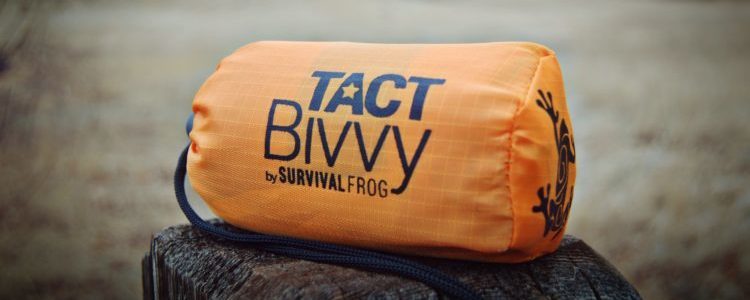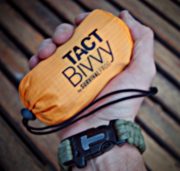
Ready for an adventure that keeps you warm, dry, and lightweight even when the weather throws everything at you? Then it’s time to discover the powerful bivy sack.
Bivy sacks are a game-changer in the world of camping and survival gear. When the elements are harsh, you need something tough, lightweight, and easy to carry.
While tents are great, they can be bulky and heavy. Bivy sacks? Not so much!
Instead of hauling around a 4-5 lb. tent, a these light weight shelters lets you carry a 1-2 lb. solution that still offers excellent protection from cold, wind, and rain.
Top Bivy Sacks On The Market
When choosing the best bivy sack, you’ve got two main options to consider:
- High-End Bivies
- Emergency-Use Bivies
High-End
These are the top-tier bivy sacks crafted for extreme conditions. Think rugged mountain expeditions, expedition camping, or high-altitude treks.
These babies come with all the bells and whistles, from waterproof Gore-Tex fabric to breathable mesh for ventilation. And while they’re typically pricier, they’re built to handle the toughest elements and provide long-lasting performance.
Here are some of the most highly-rated ones:
RAB is a British company that makes great mountaineering gear.
They’re finally becoming more well-known in the US.
But you can still find their high-quality gear reasonably priced as they try to earn a following here.
The Storm Spartan provides what the name implies - a minimalist shelter from the elements.
There are no poles or fancy options, just a simple, breathable fabric cover with a mesh vent panel.
They claim a wider sleeping bag profile than other manufacturers. This should give you more space to move around in your sleep.
If you’re looking for a durable option with fewer elements to break down, this bivy sack is hard to beat!
↓ RAB Storm – The Ultimate Cold-Weather Companion
Tennier has supplied integrated sleeping bags and emergency sacks to the US military for years.
These modular sleep systems combine a waterproof Gore-Tex outer bivy sack with two different weights of liner bags.
The specs claim it can provide insulation down to -40deg.
It’s not lightweight, but you know this gear has been tested.
I’m not sure I’d want to test sleeping in -40deg. But you know some poor recruit had to do it after carrying an 80lb pack and his rifle for 12 miles.
↓ Military-Grade Modular System – For Extreme Conditions
The Helium Bivy is renowned for its simplicity in setup and breakdown. 14% lighter than its predecessor, the Helium Bivy offers the essentials for outdoor minimalism without compromising.
Thru-hikers and bikepackers particularly favor this model for its compact design and weight efficiency.
Built with the robust, lightweight, and waterproof Pertex Diamond Fuse technology, it ensures durability and protection. The user-friendly clamshell opening enhances accessibility and durability, making it a reliable companion for expeditions.
Perfect for those who prioritize speed, agility, and performance, the Helium Bivy is the ultimate choice for the efficiency-focused adventurer.
↓ Outdoor Research Helium Bivy – Lightweight & Durable
Emergency
These are your compact, lifesaving sacks designed for emergency survival situations.
They’re super lightweight, packable, and typically made with heat-reflective mylar to trap body heat. They’re not the ideal choice for harsh storms, but for quick shelters in unexpected situations, they work wonders.
Here’s some top-rated options:
This one is MY top pick.
IT's an incredible piece of survival gear.
Small enough to fit in your hand, this survival blanket utilizes Mylar.
Mylar provides the highest quality, most effective emergency blanket around.
And because it's taped together, it traps your body heat inside more like a sleeping bag than a blanket.
The Tact Bivvy is the best bang for your buck when you compare weight to warmth.
It provides maximum heat with minimal weight.
Making it perfect for bug-out bags, get-home bags, survival packs, or glove boxes.
Not only that, but it is windproof, waterproof, easy to use, and includes a small stuff sack.
This helps keep it stored neatly when you are not using it.
And the best part? It's affordable. At this price, it's an accessible survival tool for everyone.
Field Tested
We even tested the Tact Bivvy on a chilly 40-degree overcast day. "Just In Case," Jack (our managing editor) recorded temperatures inside the Tact Bivvy, and after only 10 minutes, it was a warm 82 degrees.
It was so warm inside the Tact Bivvy that he got out shortly after 10 minutes to keep from overheating.
If it works this well on a cool 40-degree day, it's a legitimate lifesaver in below-zero survival situations.
The bottom line is - The Tact Bivvy works and is excellent for cold-weather survival.
I recommend you get one for your bug-out bag, one for your medical first aid kit, one for your car, and your home.
↓ TACT Bivvy – Your Go-To Emergency Shelter
This is a bivy sack with no extra bells or whistles.
It falls more into the emergency shelter than the adventure sack. So it's perfect for saving your life in a pinch.
Its water-resistant, durable fabric will keep you warm and dry because it will reflect 70% of radiated body heat and resists punctures and tears.
It also features:
- a full-side zipper system
- a draw-cord hood closure
- and a foot box for comfort
↓ SOL Escape Bivvy – Perfect For Emergency Shelter
The last "bivy" option is little more than metallic foil meant to reflect your body heat.
I’ve found they’re difficult to manage in the wind. But wrapping them around me inside my sleeping bag adds some added insulation.
At an ounce or so each, they fold into a tiny flat package that slips into any corner pocket.
I keep one inside my first aid kit, where it’s been useful for treating shock for rescue operations.
As a side note: You can use these to reflect the direct sun and heat AWAY in hot sunny conditions.
So they make an excellent sunshade tarp in the desert!
What Is A Bivy Sack?
A bivy sack (short for bivouac sack) is a compact, one-person shelter designed to provide quick protection against the elements. Think of it as a super-portable, bare-bones tent or a lightweight shelter system.
The term “bivouac” means temporary shelter, so a bivy sack is all about offering instant refuge in a minimal package.
But don’t be fooled—while they’re smaller than tents, they’re extra durable. Made from waterproof materials, they keep you safe from rain, wind, and even snow. And, modern models are more breathable than ever before.
With a bivy sack, you’re not just “roughing it”—you’re staying warm, dry, and protected. Perfect for backcountry adventures, emergency scenarios, or anyone who wants a minimalist camping experience.
↓ The Truth About Bivvy Sacks
Key Features
When searching for the best bivy sack, you want to pay attention to the following features:
Durability
A great one must be able to withstand rough conditions. Look for ripstop fabric—the same material used in tough tents.
Weight
If you’re backpacking, weight is crucial. Most weigh between 1 and 2 pounds, depending on the design and materials.
Pack Size
Some bivies pack down to the size of a water bottle! Lightweight and compact is the name of the game.
Weather Resistance
Most are designed to be waterproof, but check the material for extra windproofing and breathability.
Affordability
Expect to pay more for high-quality fabrics (like Gore-Tex), but basic emergency bivy sacks are often very affordable.
Common Myths – Busted!
Myth 1: They’re Only For Experts
False! Bivvies are perfect for everyone. From weekend hikers to survivalists to travel light enthusiasts.
Myth 2: They’re Uncomfortable
While you’re not lounging in luxury, bivy sacks are far more comfortable than you think, especially when paired with the right sleeping system.
Myth 3: You Can’t Use One In Winter
With the right sleeping bag and insulation, a bivy can be an excellent winter shelter.
Myth 4: They’re NOT As Effective As A Tent
Bivy sacks can be just as effective—even more so in some cases—because they keep your body heat trapped.
Who Needs One?
So, who should own a bivy sack?
– Backcountry explorers seeking lightweight shelter.
– Survivalists who want compact emergency gear.
– Hikers, campers, and adventurers who want to travel light and fast.
A bivy sack is the ideal companion for those who prioritize speed, efficiency, and protection. It’s not about comfort—it’s about survival when every ounce counts.

Prepare, Adapt & Overcome,
P.s. - I just found out 2 out of 3 Americans don’t feel prepared for a 3 day disaster!!!
I guess this goes to show how modern society continues to embrace ‘living a fragile life.’ What’s crazy is… it’s so easy to fix.
To make sure YOU have the basics, watch our FREE training on “10 Simple Steps To Basic Preparedness” that shows you HOW.
Nothing crazy here… this isn’t doomsday prepping... just the basics every responsible adult should have before a disaster strikes.Why You Can Trust Skilled Survival...
Go here now to review a full breakdown of:
- Who We Are
- Our Credentials
- Our Mission
- & Product Recommendations...
Here are a few highlights of our teams credentials & certifications:
- Certified Member of a Mountain Search & Rescue Organization
- Plant Emergency & Safety Leader for a Major Food Manufacturer
- Member of the 10TH Mountain Division Hut Association
- Certifications: Avalanche 1, WFR, CPR
- Official Gear Tester for Numerous Outdoor Gear Companies
- Countless Multiday Backpacking trips into Remote Wilderness
- Bachelor's Degree In Mechanical Engineering
- Bachelor's Degree In Civil Engineering
- Bachelor's Degree In Biomedical Engineering
"It takes 20 years to build a reputation and five minutes to ruin it." - Warren Buffett
We're fully aware that trust is NOT something you GET but is EARNED.
And we'll continue to earn YOUR trust through our forthright and honest approach with each new Blog Post, Guide & Product we create...
P.s - I just took this FREE 60-second 'Readiness Score Quiz'👇
AND... I've still got a few gaps in my preps...🤔 But at least, I'm not part of 'The Fragile Masses'. 👍 Find out where YOU stand by answering a few questions...

Recommended Reading
LifeStraw Review: An Expert Puts It To The Ultimate Test
LifeStraw Review - with no moving parts, chemical additions, or batteries, it provides a lightweight, compact filter to treat up to 4000L...
Best Survival Bow: 16 Surprising Reasons YOU Should Get One
A survival bow is one of the most underappreciated weapons I think EVERYONE should own. Here are 16 reasons why YOU should get one today.
Best Survival Hatchets: Tough Enough To Outlast The Wild
Not all hatchets are created equal. A quality survival hatchet can do tasks even a survival knife cannot. Here's the one I carry in my pack.
Best Survival Radios: Why You Must Secure One (before SHTF)
Be the ONE who knows what the hell is going on after SHTF. Here's how to set yourself up with a reliable survival radio in a future disaster.
Best EDC Flashlight: Simple, Small, Compact & Super Bright
The best edc flashlight is durable, bright, compact and worth carrying! In this guide, we review the best one to make your search easy.
11 Proven DIY Survival Gear Projects ANYONE Can Follow
Building DIY survival gear doesn't NEED to be complicated to be effective. Here are the 11 best projects you can finish in just a few hours.










